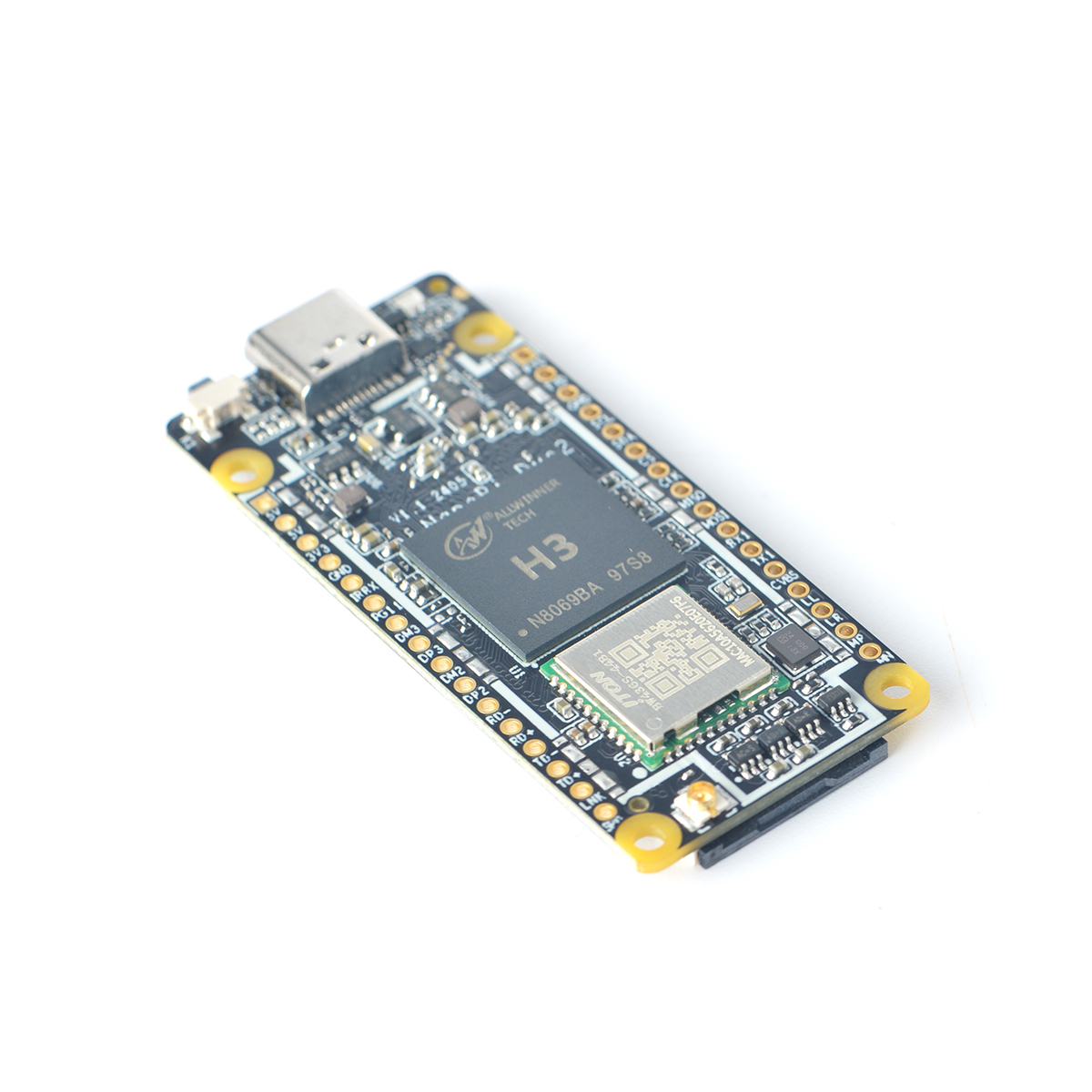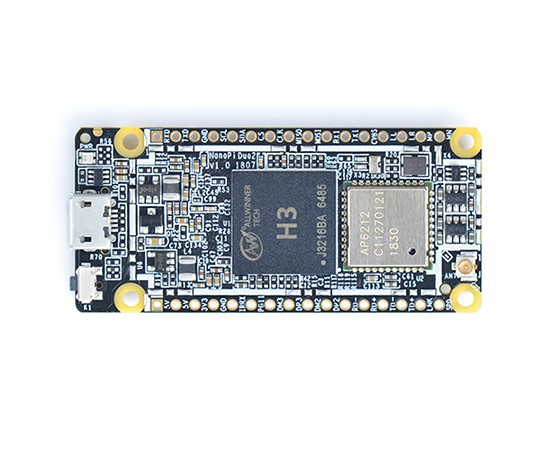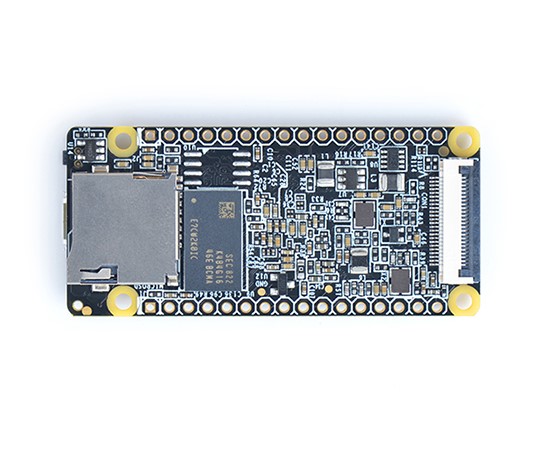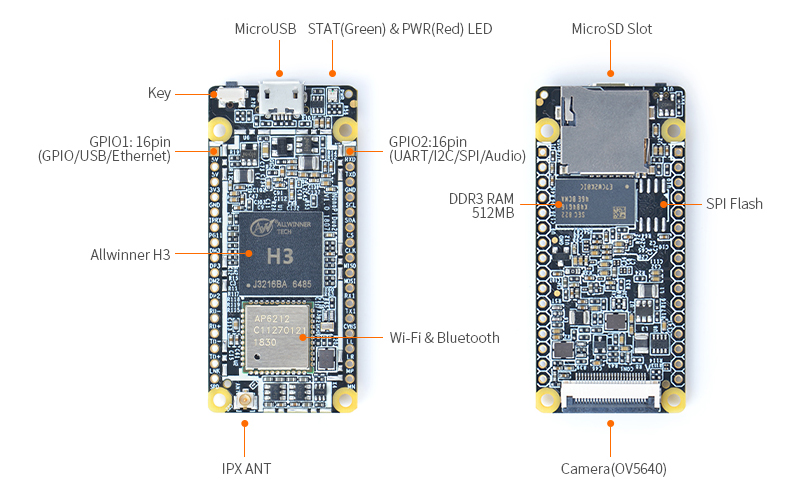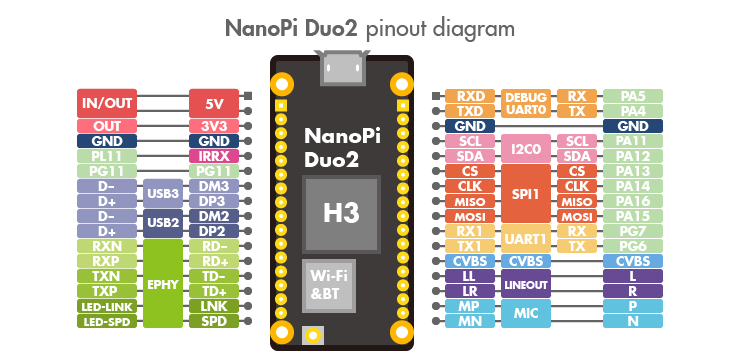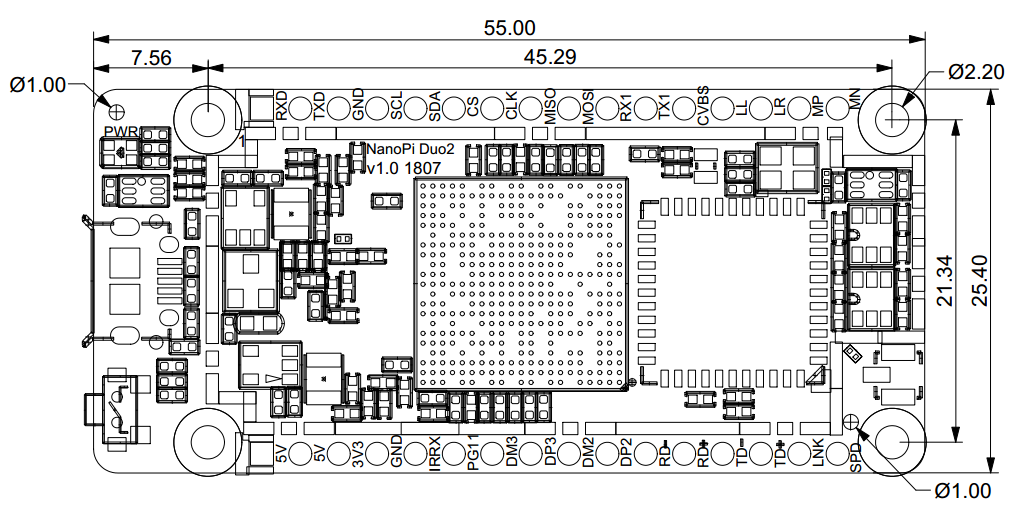Difference between revisions of "NanoPi Duo2"
(→介绍) |
(→Introduction) |
||
| Line 6: | Line 6: | ||
[[File:NanoPi Duo2-3.jpg|thumb|frameless|300px|Back]] | [[File:NanoPi Duo2-3.jpg|thumb|frameless|300px|Back]] | ||
* The NanoPi Duo2("Duo2") is an ARM board designed and developed by FriendlyELEC for makers and hobbyists. It is only 55 x 25.4mm. It features Allwinner quad-core A7 processor H3, and has 256M/512M DDR3 RAM, onboard WiFi & bluetooth module and an OV5640 camera interface. It works with Linux variants such as Ubuntu Core. | * The NanoPi Duo2("Duo2") is an ARM board designed and developed by FriendlyELEC for makers and hobbyists. It is only 55 x 25.4mm. It features Allwinner quad-core A7 processor H3, and has 256M/512M DDR3 RAM, onboard WiFi & bluetooth module and an OV5640 camera interface. It works with Linux variants such as Ubuntu Core. | ||
| − | * The NanoPi Duo2 is tiny and compact with rich interfaces and ports. It takes power input from its MicroUSB port and can be booted from a Micro SD card. It works with general bread-boards. Interface pins such as USB, SPI, UART, I2C, PWM, IR, audio input & output and | + | * The NanoPi Duo2 is tiny and compact with rich interfaces and ports. It takes power input from its MicroUSB port and can be booted from a Micro SD card. It works with general bread-boards. Interface pins such as USB, SPI, UART, I2C, PWM, IR, audio input & output and Fast Ethernet etc are populated. |
| − | * NanoPi | + | * The NanoPi Duo2 supports software utilities such as WiringNP and Python etc. These are all open source. It is suited for various IoT applications. |
==资源特性== | ==资源特性== | ||
Revision as of 07:03, 11 October 2018
Contents
- 1 Introduction
- 2 资源特性
- 3 接口布局和尺寸
- 4 快速入门
- 5 Work with FriendlyCore
- 5.1 Introduction
- 5.2 System Login
- 5.3 Configure System with npi-config
- 5.4 Develop Qt Application
- 5.5 Setup Program to AutoRun
- 5.6 Extend TF Card's Section
- 5.7 Transfer files using Bluetooth
- 5.8 WiFi
- 5.9 Setup Wi-Fi Hotspot
- 5.10 Bluetooth
- 5.11 Ethernet Connection
- 5.12 WiringPi and Python Wrapper
- 5.13 Custom welcome message
- 5.14 Modify timezone
- 5.15 Set Audio Device
- 5.16 Connect to DVP Camera OV5640
- 5.17 Connect to USB Camera(FA-CAM202)
- 5.18 Check CPU's Working Temperature
- 5.19 Test Infrared Receiver
- 5.20 How to install and use docker (for armhf system)
- 6 如何编译FriendlyCore系统
- 7 资源链接
- 8 硬件更新
- 9 ChangeLog
1 Introduction
- The NanoPi Duo2("Duo2") is an ARM board designed and developed by FriendlyELEC for makers and hobbyists. It is only 55 x 25.4mm. It features Allwinner quad-core A7 processor H3, and has 256M/512M DDR3 RAM, onboard WiFi & bluetooth module and an OV5640 camera interface. It works with Linux variants such as Ubuntu Core.
- The NanoPi Duo2 is tiny and compact with rich interfaces and ports. It takes power input from its MicroUSB port and can be booted from a Micro SD card. It works with general bread-boards. Interface pins such as USB, SPI, UART, I2C, PWM, IR, audio input & output and Fast Ethernet etc are populated.
- The NanoPi Duo2 supports software utilities such as WiringNP and Python etc. These are all open source. It is suited for various IoT applications.
2 资源特性
- CPU: Allwinner H3, Quad-core Cortex-A7 Up to 1.2GHz
- DDR3 RAM: 512M
- Connectivity: 10/100M Ethernet
- WiFi: 802.11b/g/n
- Bluetooth: Bluetooth V4.0 of 1, 2 and 3 Mbps.
- Camera: OV5640
- Key: GPIO Key
- USB Host: 2.54mm pin x2, exposed in 2.54mm pitch pin header
- MicroSD Slot x 1
- MicroUSB: OTG and power input
- Debug Serial Interface: exposed in 2.54mm pitch pin header
- Audio input/output Interface: exposed in 2.54mm pitch pin header
- GPIO1: 2.54mm spacing 16pin. It includes UART, SPI, I2C, Audio etc
- GPIO2: 2.54mm spacing 16pin. It includes USB,10/100M Ethernet, IO etc
- PCB Dimension: 25.4 x 55mm
- Power Supply: DC 5V/2A
- Temperature measuring range: -40℃ to 80℃
- OS/Software: U-boot,Linux Kernel 4.11.2 (mainline) , Ubuntu 16.04.2 LTS (Xenial)
- Weight: xxg(With Pin-headers)
3 接口布局和尺寸
3.1 接口布局
- GPIO管脚定义
Pin# GPIO1 Name Linux gpio Pin# GPIO2 Name Linux gpio 1 5V VDD_5V 17 RXD DEBUG_RX(UART_RXD0)/GPIOA5/PWM0 5 2 5V VDD_5V 18 TXD DEBUG_TX(UART_TXD0)/GPIOA4 4 3 3V3 SYS_3.3V 19 GND GND 4 GND GND 20 SCL I2C0_SCL/GPIOA11 11 5 IRRX GPIOL11/IR-RX 363 21 SDA I2C0_SDA/GPIOA12 12 6 PG11 GPIOG11 203 21 CS UART3_TX/SPI1_CS/GPIOA13 13 7 DM3 USB-DM3 23 CLK UART3_RX/SPI1_CLK/GPIOA14 14 8 DP3 USB-DP3 24 MISO UART3_CTS/SPI1_MISO/GPIOA16 16 9 DM2 USB-DM2 25 MOSI UART3_RTS/SPI1_MOSI/GPIOA15 15 10 DP2 USB-DP2 26 RX1 UART1_RX/GPIOG7 199 11 RD- EPHY-RXN 27 TX1 UART1_TX/GPIOG6 198 12 RD+ EPHY-RXP 28 CVBS CVBS 13 TD- EPHY-TXN 29 LL LINEOUT_L 14 TD+ EPHY-TXP 30 LR LINEOUT_R 15 LNK EPHY-LED-LINK 31 MP MIC_P 16 SPD EPHY-LED-SPD 32 MN MIC_N
- 说明
- SYS_3.3V: 3.3V电源输出
- VDD_5V: 5V电源输入/输出。当电压大于MicroUSB时,向板子供电,否则板子从MicroUSB取电。输入范围:4.7~5.6V
- 全部信号引脚均为3.3V电平,输出电流为5mA,可以带动小负荷模块,io都不能带负载
- 更详细的信息请查看原理图,NanoPi Duo2原理图
3.2 机械尺寸
4 快速入门
4.1 准备工作
要开启你的NanoPi Duo2新玩具,请先准备好以下硬件
- NanoPi Duo2主板
- microSD卡/TF卡: Class10或以上的 8GB SDHC卡
- 一个microUSB接口的外接电源,要求输出为5V/2A(可使用同规格的手机充电器)
- 一台电脑,需要联网,建议使用Ubuntu 16.04 64位系统
- 一个串口模块
4.2 经测试使用的TF卡
制作启动NanoPi Duo2的TF卡时,建议Class10或以上的 8GB SDHC卡。以下是经友善之臂测试验证过的高速TF卡:
- SanDisk闪迪 TF 8G Class10 Micro/SD 高速 TF卡:
- SanDisk闪迪 TF128G 至尊高速MicroSDXC TF 128G Class10 48MB/S:
- 川宇 8G手机内存卡 8GTF卡存储卡 C10高速class10 micro SD卡:
4.3 安装系统
4.3.1 下载系统固件
首先访问下载地址下载需要的固件文件(officail-ROMs目录)和烧写工具(tools目录):
使用以下固件: nanopi-duo2_sd_friendlycore-xenial_4.14_armhf_YYYYMMDD.img.zip 基于UbuntuCore构建的FriendlyCore系统固件,使用Linux-4.14内核 烧写工具: win32diskimager.rar Windows平台下的系统烧写工具,Linux平台下可以用dd命令烧写系统
5 Work with FriendlyCore
5.1 Introduction
FriendlyCore is a light Linux system without X-windows, based on ubuntu core, It uses the Qt-Embedded's GUI and is popular in industrial and enterprise applications.
Besides the regular Ubuntu Core's features FriendlyCore has the following additional features:
- it integrates Qt4.8;
- it integrates NetworkManager;
- it has bluez and Bluetooth related packages;
- it has alsa packages;
- it has npi-config;
- it has RPiGPIO, a Python GPIO module;
- it has some Python/C demo in /root/ directory;
- it enables 512M-swap partition;
5.2 System Login
- If your board is connected to an HDMI monitor you need to use a USB mouse and keyboard.
- If you want to do kernel development you need to use a serial communication board, ie a PSU-ONECOM board, which will
You can use a USB to Serial conversion board too.
Make sure you use a 5V/2A power to power your board from its MicroUSB port:
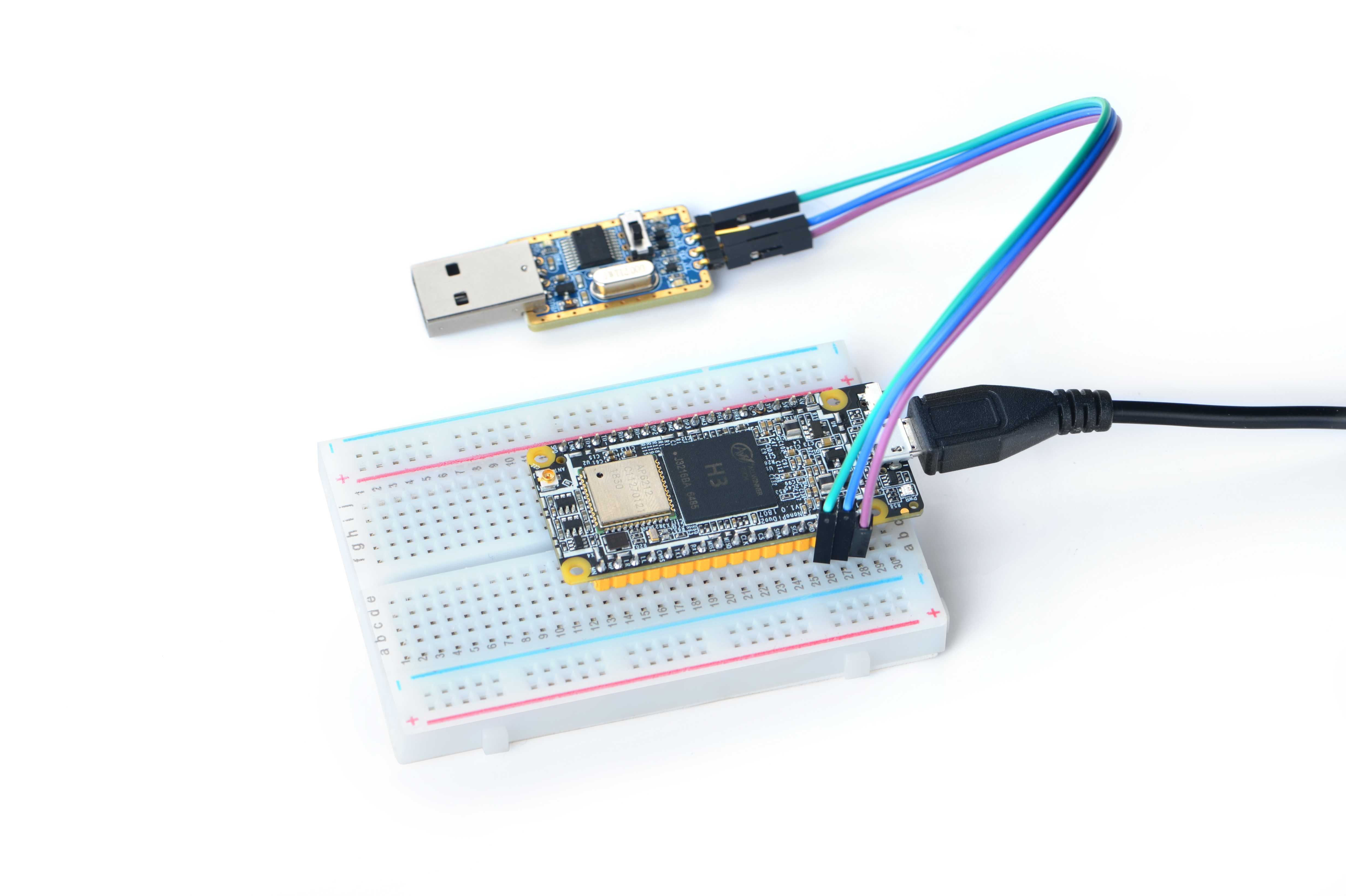
- FriendlyCore User Accounts:
Non-root User:
User Name: pi Password: pi
Root:
User Name: root Password: fa
The system is automatically logged in as "pi". You can do "sudo npi-config" to disable auto login.
- Update packages
$ sudo apt-get update
5.3 Configure System with npi-config
The npi-config is a commandline utility which can be used to initialize system configurations such as user password, system language, time zone, Hostname, SSH switch , Auto login and etc. Type the following command to run this utility.
$ sudo npi-config
Here is how npi-config's GUI looks like:

5.4 Develop Qt Application
Please refer to: How to Build and Install Qt Application for FriendlyELEC Boards
5.5 Setup Program to AutoRun
You can setup a program to autorun on system boot with npi-config:
sudo npi-configGo to Boot Options -> Autologin -> Qt/Embedded, select Enable and reboot.
5.6 Extend TF Card's Section
When FriendlyCore is loaded the TF card's section will be automatically extended.You can check the section's size by running the following command:
$ df -h
5.7 Transfer files using Bluetooth
Take the example of transferring files to the mobile phone. First, set your mobile phone Bluetooth to detectable status, then execute the following command to start Bluetooth search.:
hcitool scan
Search results look like:
Scanning ...
2C:8A:72:1D:46:02 HTC6525LVWThis means that a mobile phone named HTC6525LVW is searched. We write down the MAC address in front of the phone name, and then use the sdptool command to view the Bluetooth service supported by the phone:
sdptool browser 2C:8A:72:1D:46:02
Note: Please replace the MAC address in the above command with the actual Bluetooth MAC address of the mobile phone.
This command will detail the protocols supported by Bluetooth for mobile phones. What we need to care about is a file transfer service called OBEX Object Push. Take the HTC6525LVW mobile phone as an example. The results are as follows:
Service Name: OBEX Object Push Service RecHandle: 0x1000b Service Class ID List: "OBEX Object Push" (0x1105) Protocol Descriptor List: "L2CAP" (0x0100) "RFCOMM" (0x0003) Channel: 12 "OBEX" (0x0008) Profile Descriptor List: "OBEX Object Push" (0x1105) Version: 0x0100
As can be seen from the above information, the channel used by the OBEX Object Push service of this mobile phone is 12, we need to pass it to the obexftp command, and finally the command to initiate the file transfer request is as follows:
obexftp --nopath --noconn --uuid none --bluetooth -b 2C:8A:72:1D:46:02 -B 12 -put example.jpg
Note: Please replace the MAC address, channel and file name in the above command with the actual one.
After executing the above commands, please pay attention to the screen of the mobile phone. The mobile phone will pop up a prompt for pairing and receiving files. After confirming, the file transfer will start.
Bluetooth FAQ:
1) Bluetooth device not found on the development board, try to open Bluetooth with the following command:
rfkill unblock 02) Prompt can not find the relevant command, you can try to install related software with the following command:
apt-get install bluetooth bluez obexftp openobex-apps python-gobject ussp-push5.8 WiFi
For either an SD WiFi or a USB WiFi you can connect it to your board in the same way. The APXX series WiFi chips are SD WiFi chips. By default FriendlyElec's system supports most popular USB WiFi modules. Here is a list of the USB WiFi modules we tested:
Index Model 1 RTL8188CUS/8188EU 802.11n WLAN Adapter 2 RT2070 Wireless Adapter 3 RT2870/RT3070 Wireless Adapter 4 RTL8192CU Wireless Adapter 5 mi WiFi mt7601 6 5G USB WiFi RTL8821CU 7 5G USB WiFi RTL8812AU
You can use the NetworkManager utility to manage network. You can run "nmcli" in the commandline utility to start it. Here are the commands to start a WiFi connection:
- Change to root
$ su root
- Check device list
$ nmcli devNote: if the status of a device is "unmanaged" it means that device cannot be accessed by NetworkManager. To make it accessed you need to clear the settings under "/etc/network/interfaces" and reboot your system.
- Start WiFi
$ nmcli r wifi on- Scan Surrounding WiFi Sources
$ nmcli dev wifi- Connect to a WiFi Source
$ nmcli dev wifi connect "SSID" password "PASSWORD" ifname wlan0
The "SSID" and "PASSWORD" need to be replaced with your actual SSID and password.If you have multiple WiFi devices you need to specify the one you want to connect to a WiFi source with iface
If a connection succeeds it will be automatically setup on next system reboot.
For more details about NetworkManager refer to this link: Use NetworkManager to configure network settings
If your USB WiFi module doesn't work most likely your system doesn't have its driver. For a Debian system you can get a driver from Debian-WiFi and install it on your system. For a Ubuntu system you can install a driver by running the following commands:
$ apt-get install linux-firmware
In general all WiFi drivers are located at the "/lib/firmware" directory.
5.9 Setup Wi-Fi Hotspot
Run the following command to enter AP mode:
$ su root $ turn-wifi-into-apmode yes
You will be prompted to type your WiFi hotspot's name and password and then proceed with default prompts.
After this is done you will be able to find this hotspot in a neadby cell phone or PC. You can login to this board at 192.168.8.1:
$ ssh root@192.168.8.1
When asked to type a password you can type "fa".
To speed up your ssh login you can turn off your wifi by running the following command:
$ iwconfig wlan0 power offTo switch back to Station mode run the following command:
$ turn-wifi-into-apmode no5.10 Bluetooth
Search for surrounding bluetooth devices by running the following command:
$ su root
$ hciconfig hci0 up
$ hcitool scanYou can run "hciconfig" to check bluetooth's status.
5.11 Ethernet Connection
If a board is connected to a network via Ethernet before it is powered on it will automatically obtain an IP with DHCP activated after it is powered up. If you want to set up a static IP refer to: Use NetworkManager to configure network settings。
5.12 WiringPi and Python Wrapper
- WiringNP: NanoPi NEO/NEO2/Air GPIO Programming with C
- RPi.GPIO : NanoPi NEO/NEO2/Air GPIO Programming with Python
5.13 Custom welcome message
The welcome message is printed from the script in this directory:
/etc/update-motd.d/
For example, to change the FriendlyELEC LOGO, you can change the file /etc/update-motd.d/10-header. For example, to change the LOGO to HELLO, you can change the following line:
TERM=linux toilet -f standard -F metal $BOARD_VENDOR
To:
TERM=linux toilet -f standard -F metal HELLO
5.14 Modify timezone
For exampe, change to Shanghai timezone:
sudo rm /etc/localtime sudo ln -ls /usr/share/zoneinfo/Asia/Shanghai /etc/localtime
5.15 Set Audio Device
If your system has multiple audio devices such as HDMI-Audio, 3.5mm audio jack and I2S-Codec you can set system's default audio device by running the following commands.
- After your board is booted run the following commands to install alsa packages:
$ apt-get update $ apt-get install libasound2 $ apt-get install alsa-base $ apt-get install alsa-utils
- After installation is done you can list all the audio devices by running the following command. Here is a similar list you may see after you run the command:
$ aplay -l card 0: HDMI card 1: 3.5mm codec card 2: I2S codec
"card 0" is HDMI-Audio, "card 1" is 3.5mm audio jack and "card 2" is I2S-Codec. You can set default audio device to HDMI-Audio by changing the "/etc/asound.conf" file as follows:
pcm.!default { type hw card 0 device 0 } ctl.!default { type hw card 0 }
If you change "card 0" to "card 1" the 3.5mm audio jack will be set to the default device.
Copy a .wav file to your board and test it by running the following command:
$ aplay /root/Music/test.wav
You will hear sounds from system's default audio device.
If you are using H3/H5/H2+ series board with mainline kernel, the easier way is using npi-config。
5.16 Connect to DVP Camera OV5640
For NanoPi-Duo2 the OV5640 can work with Linux-4.14 Kernel.
The NanoPi-Duo2 has support for OV5640 cameras and you can directly connect an OV5640 camera to the board. Here is a hardware setup:
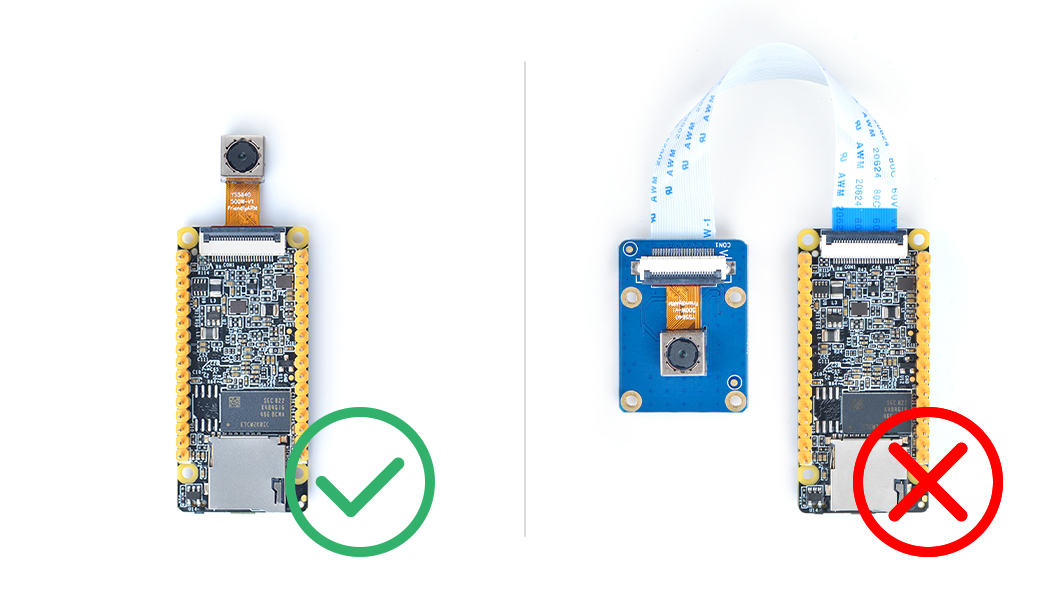
connect your board to camera module. Then boot OS, connect your board to a network, log into the board as root and run "mjpg-streamer":
$ cd /root/C/mjpg-streamer $ make $ ./start.sh
You need to change the start.sh script and make sure it uses a correct /dev/videoX node. You can check your camera's node by running the following commands:
$ apt-get install v4l-utils $ v4l2-ctl -d /dev/video0 -D Driver Info (not using libv4l2): Driver name : sun6i-video Card type : sun6i-csi Bus info : platform:camera Driver version: 4.14.0 ...
The above messages indicate that "/dev/video0" is camera's device node.The mjpg-streamer application is an open source video steam server. After it is successfully started the following messages will be popped up:
$ ./start.sh i: Using V4L2 device.: /dev/video0 i: Desired Resolution: 1280 x 720 i: Frames Per Second.: 30 i: Format............: YUV i: JPEG Quality......: 90 o: www-folder-path...: ./www/ o: HTTP TCP port.....: 8080 o: username:password.: disabled o: commands..........: enabled
start.sh runs the following two commands:
export LD_LIBRARY_PATH="$(pwd)" ./mjpg_streamer -i "./input_uvc.so -d /dev/video0 -y 1 -r 1280x720 -f 30 -q 90 -n -fb 0" -o "./output_http.so -w ./www"
Here are some details for mjpg_streamer's major options:
-i: input device. For example "input_uvc.so" means it takes input from a camera;
-o: output device. For example "output_http.so" means the it transmits data via http;
-d: input device's subparameter. It defines a camera's device node;
-y: input device's subparameter. It defines a camera's data format: 1:yuyv, 2:yvyu, 3:uyvy 4:vyuy. If this option isn't defined MJPEG will be set as the data format;
-r: input device's subparameter. It defines a camera's resolution;
-f: input device's subparameter. It defines a camera's fps. But whether this fps is supported depends on its driver;
-q: input device's subparameter. It defines the quality of an image generated by libjpeg soft-encoding;
-n: input device's subparameter. It disables the dynctrls function;
-fb: input device's subparameter. It specifies whether an input image is displayed at "/dev/fbX";
-w: output device's subparameter. It defines a directory to hold web pages;
In our case the board's IP address was 192.168.1.230. We typed 192.168.1.230:8080 in a browser and were able to view the images taken from the camera's. Here is what you would expect to observe:
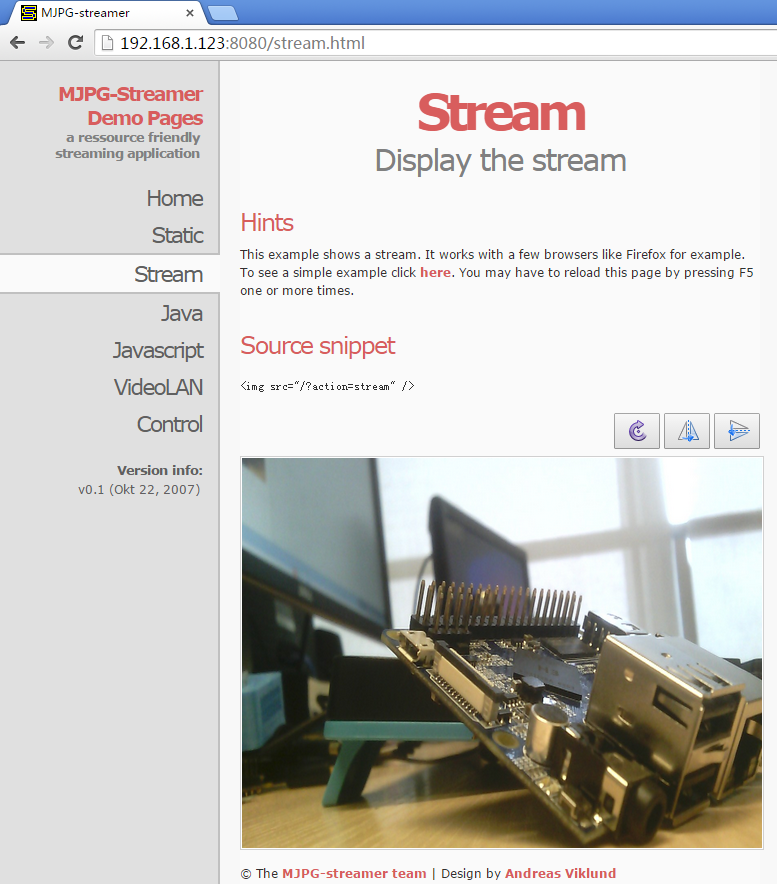
The mjpg-streamer utility uses libjpeg to software-encode steam data. The Linux-4.14 based ROM currently doesn't support hardware-encoding. If you use a H3 boards with Linux-3.4 based ROM you can use the ffmpeg utility to hardware-encode stream data and this can greatly release CPU's resources and speed up encoding:
$ ffmpeg -t 30 -f v4l2 -channel 0 -video_size 1280x720 -i /dev/video0 -pix_fmt nv12 -r 30 \ -b:v 64k -c:v cedrus264 test.mp4
By default it records a 30-second video. Typing "q" stops video recording. After recording is stopped a test.mp4 file will be generated.
5.17 Connect to USB Camera(FA-CAM202)
The FA-CAM202 is a 200M USB camera. Connect your board to camera module. Then boot OS, connect your board to a network, log into the board as root and run "mjpg-streamer":
$ cd /root/C/mjpg-streamer $ make $ ./start.sh
You need to change the start.sh script and make sure it uses a correct /dev/videoX node. You can check your camera's node by running the following commands:
$ apt-get install v4l-utils $ v4l2-ctl -d /dev/video0 -D Driver Info (not using libv4l2): Driver name : uvcvideo Card type : HC 3358+2100: HC 3358+2100 / USB 2.0 Camera: USB 2.0 Camera Bus info : usb-1c1b000.usb-1 ...
The above messages indicate that "/dev/video0" is camera's device node.The mjpg-streamer application is an open source video steam server. After it is successfully started the following messages will be popped up:
$ ./start.sh i: Using V4L2 device.: /dev/video0 i: Desired Resolution: 1280 x 720 i: Frames Per Second.: 30 i: Format............: YUV i: JPEG Quality......: 90 o: www-folder-path...: ./www/ o: HTTP TCP port.....: 8080 o: username:password.: disabled o: commands..........: enabled
start.sh runs the following two commands:
export LD_LIBRARY_PATH="$(pwd)" ./mjpg_streamer -i "./input_uvc.so -d /dev/video0 -y 1 -r 1280x720 -f 30 -q 90 -n -fb 0" -o "./output_http.so -w ./www"
Here are some details for mjpg_streamer's major options:
-i: input device. For example "input_uvc.so" means it takes input from a camera;
-o: output device. For example "output_http.so" means the it transmits data via http;
-d: input device's subparameter. It defines a camera's device node;
-y: input device's subparameter. It defines a camera's data format: 1:yuyv, 2:yvyu, 3:uyvy 4:vyuy. If this option isn't defined MJPEG will be set as the data format;
-r: input device's subparameter. It defines a camera's resolution;
-f: input device's subparameter. It defines a camera's fps. But whether this fps is supported depends on its driver;
-q: input device's subparameter. It defines the quality of an image generated by libjpeg soft-encoding;
-n: input device's subparameter. It disables the dynctrls function;
-fb: input device's subparameter. It specifies whether an input image is displayed at "/dev/fbX";
-w: output device's subparameter. It defines a directory to hold web pages;
In our case the board's IP address was 192.168.1.230. We typed 192.168.1.230:8080 in a browser and were able to view the images taken from the camera's. Here is what you would expect to observe:

5.18 Check CPU's Working Temperature
You can get CPU's working temperature by running the following command:
$ cpu_freq
Aavailable frequency(KHz):
480000 624000 816000 1008000
Current frequency(KHz):
CPU0 online=1 temp=26548C governor=ondemand freq=624000KHz
CPU1 online=1 temp=26548C governor=ondemand freq=624000KHz
CPU2 online=1 temp=26548C governor=ondemand freq=624000KHz
CPU3 online=1 temp=26548C governor=ondemand freq=624000KHzThis message means there are currently four CPUs working. All of their working temperature is 26.5 degree in Celsius and each one's clock is 624MHz.
Set CPU frequency:
$ cpu_freq -s 1008000
Aavailable frequency(KHz):
480000 624000 816000 1008000
Current frequency(KHz):
CPU0 online=1 temp=36702C governor=userspace freq=1008000KHz
CPU1 online=1 temp=36702C governor=userspace freq=1008000KHz
CPU2 online=1 temp=36702C governor=userspace freq=1008000KHz
CPU3 online=1 temp=36702C governor=userspace freq=1008000KHz
5.19 Test Infrared Receiver
Note: Please Check your board if IR receiver exist.
By default the infrared function is disabled you can enable it by using the npi-config utility:
$ npi-config
6 Advanced Options Configure advanced settings
A8 IR Enable/Disable IR
ir Enable/Disable ir[enabled]Reboot your system and test its infrared function by running the following commands:
$ apt-get install ir-keytable $ echo "+rc-5 +nec +rc-6 +jvc +sony +rc-5-sz +sanyo +sharp +mce_kbd +xmp" > /sys/class/rc/rc0/protocols # Enable infrared $ ir-keytable -t Testing events. Please, press CTRL-C to abort.
"ir-keytable -t" is used to check whether the receiver receives infrared signals. You can use a remote control to send infrared signals to the receiver. If it works you will see similar messages as follows:
1522404275.767215: event type EV_MSC(0x04): scancode = 0xe0e43 1522404275.767215: event type EV_SYN(0x00). 1522404278.911267: event type EV_MSC(0x04): scancode = 0xe0e42 1522404278.911267: event type EV_SYN(0x00).
5.20 How to install and use docker (for armhf system)
5.20.1 How to Install Docker
Run the following commands:
sudo apt-get update sudo apt-get install docker.io
5.20.2 Test Docker installation
Test that your installation works by running the simple docker image:
git clone https://github.com/friendlyarm/debian-jessie-arm-docker cd debian-jessie-arm-docker ./rebuild-image.sh ./run.sh
6 如何编译FriendlyCore系统
6.1 使用Linux-4.14 BSP
Duo2仅支持使用Linux-4.14内核,关于H3芯片系列开发板使用主线U-boot和Linux-4.14的方法,请参考维基:Mainline U-boot & Linux
7 资源链接
7.1 手册原理图等开发资料
- 原理图: NanoPi Duo2 V1.0 1807原理图
- 尺寸图: NanoPi Duo2 V1.0 1807 PCB尺寸图
- H3芯片手册 Allwinner_H3_Datasheet_V1.2.pdf
8 硬件更新
8.1 V1.0 1807
第一版
9 ChangeLog
2023-11-07
h3 FriendlyCore:
- Upgrade to Ubuntu Core 22.04;
h3 Debian Core:
- Add Debian bookworm core;
